Newhall Townsite Oil Field, Los Angeles County, California
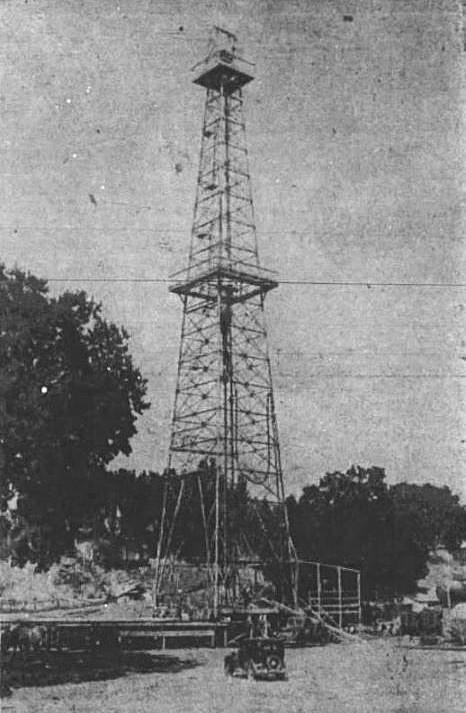
R.W. Sherman's so-called discovery well (Newhall Community 3-1) located on Hill Street (now called Wayman Street) just south of Lyons Avenue. Photo from the Newhall Signal, November 18, 1948.
The story of the Newhall Townsite oil field is mainly the story of one man, Richard W. Sherman, and his well, the Newhall Community 3-1.
CalGEM (formerly DOGGR - the Division of Oil, Gas, and Geothermal Resources) includes 40 wells in the Newhall Townsite oil field, which was named in 1951. Many of the wells were drilled before there was an actual field name. Many were outside of the Newhall city limits. Here is a spreadsheet of the wells from CalGEM(1). It was slightly modified by me. Of the 37 wells with records, only five went on production. In other words, 86.5% of the wells found no oil in commercial quantity. The output of the five wells that did go on production was meager and short-lived. The Newhall Townsite oil field was a very non-productive oil field.
In 1946, the first well to find oil in the future townsite oil field was drilled on the Braille Institute of America's lease located east of the intersection of San Fernando Road (now Newhall Avenue) and the railroad tracks. The Shell Oil Company spudded (started drilling) Braille 1 (API No. 03712844) on August 5, 1946 and completed it on August 31 at a depth of 4,712 feet. The well's initial production was 30 barrels per day. However, after only 10 days production dropped to 7.5 b/d. Not being very successful, it was plugged and abandoned in 1950. The lease was signed over to the Aurora Corporation in January of 1947. Braille 2 (API No. 03713000) was then spudded by Aurora on September 20, 1947. It was completed on October 13 at a depth of 3,586 feet. Initial production was a modest 50 b/d but, after 30 days, production dropped to 0. This well was plugged and abandoned (meaning permanently closed and sealed) in 1948.
The well that caused the most excitement and fueled the short-lived Newhall Townsite boom, was Richard W. (Dick) Sherman's Newhall Community 3-1 (API No. 03713240). Newspapers also called it Sherman Community 3-1, Sherman Community 3, Sherman 3-1, Sherman 1, Sherman 3, the Sherman discovery well, and Old Faithful. Sherman (1894-1958) began drilling on August 2, 1948. He was very tight-lipped about his wells, so almost all the well information came from professional oil scouts and "educated" guesses by oil newsmen. Newspapers, mainly the Newhall Signal (the Los Angeles Times rarely mentioned the townsite field), were extensively used to tell this story. They are not always a perfect source because, besides the guesses, contradictions sometimes occurred between the stories from one issue to the next. Another problem was that in those days the Signal was only published weekly on Thursday. However, it is virtually the only source that we have today. All the newspaper sources have links to the actual article for you to read.
According to the Newhall Signal of August 8, 1948, Newhall Community 3-1 was "the personal venture of R. W. Sherman, one of the most successful petroleum geologists in the industry. Sherman is given credit for locating both the Barnsdall and Del Valle fields."(2) The Barnsdall field was the Newhall-Potrero field.
News for the Newhall Community 3-1 well started out very positive. In November, the Signal reported that it had "encountered a promising oil structure."(3) Two weeks later, the Signal upped the ante by claiming that tests "indicate that an oil pool of major dimensions has been tapped directly under Newhall." Sherman himself "estimated a minimum flow of 500 barrels of 40 gravity oil." And "other competent observers say it is even better than that." While some test pipes were being removed from the well two days before the publication of the newspaper, there was a sudden spurt of oil to a height of about 100 feet. Gas pressure also greatly increased. "The whole neighborhood was enveloped in a fine spray of petroleum and petroleum vapors." By evening, the well was quite. "The tests proved beyond all doubt the existence of the oil producing structures and the presence of enough gas pressure to bring that oil to the surface." "But all doubt of an oil strike of major importance was dissipated." As would be expected, oil leasing activity in Newhall boomed.(4) However, another article in the same issue reported that some people were worried that town lot drilling could, not only ruin the city with overdrilling for the quick dollar, but quickly deplete the oil pool. This article also touted the advantages of a "community" lease, the lease that the Newhall Community 3-1 well was on. The many landowners part of the same lease would share equally in the profits. Fewer wells needed to be drilled extending the life of the oil pool.(5)
The headline for an article in the November 25th Signal, was "Wild lease scramble as Sherman well tests big oil and gas production." Sherman guessed that there was a "production potential of 1,500 barrels of 42 gravity oil and 4,000,000 feet of gas." "With the existence of a rich pool proved by the discovery well, the next question is the extent of that pool." For a change there was also a slight word of caution: "Veteran oilmen declare that only actual drilling will determine the actual extent of the pool." Leasing activity was still strong, but new drilling had not started.(6) Operators were waiting to see the results of the Sherman well.
In December, 1948, the Signal reported that there were rumors that salt water had entered the Sherman well. If true, that could ruin the well. Evidently, when the pumping operation first started, the well plugged up with sand and silt, blocking any oil from flowing. While trying to clean the well out, salt water entered and well pressure dropped. Operators could not locate the salt water leakage source. The "oil fever chart dropped to something like normal." Sherman's operators were preparing to use a "systematic oil exploration program" to "determine the size and extent of the Newhall oil pool." Attempts would be made to shutoff the salt water. Sherman was also planning to start a new well at a nearby location on another of his three community leases.(7)
Better news on the Sherman well came later in December from the Signal. New tests showed plenty of oil and higher gas pressure. The well well blew in "sending a shower of black oil higher than the Arcadia street ridge similar as to the oil spurt that happened the previous month. Oil flowed for 20 minutes and then choked off again." This surge of oil pushes sand "into the casing perforations and clogs the flow. This is a technical problem which is capable of solution, oil men say." More new well sites were being graded, but drilling still had not started.(8)
Then, a week later in the Signal, it was reported that last week Sherman's well "came in" or started to flow. Sherman had never given out any information since the well was started (except some guesses), but "oil reporters in the metropolitan papers guessed the well potential at 1,500 to 1,900 barrels." Since there was little storage capacity at the well, tank trucks hauled to the Richfield pumping station on north Newhall avenue. "The success of the discovery well apparently brought to an end a period of doubt about the existence of a major oil pool under the community of Newhall."(9) This would soon turn out to be a way overly-optimistic article.
The selling of oil leases picked up. Leases worth thousands were sold by the American Legion of Newhall-Saugus, the Community Church, Newhall Elementary School, Hart High School, and numerous other landowners. Many landowners received bonuses as high as $5000 just for signing the lease. The American Legion received $7000. Of course, lessors would also get a percentage of the royalties, if there were any.(10) The December, 1948, Signal reported that many new derricks have been constructed and are ready to start drilling. "The next major development must necessarily be the determination of its size and extent" of the oil field.(11)
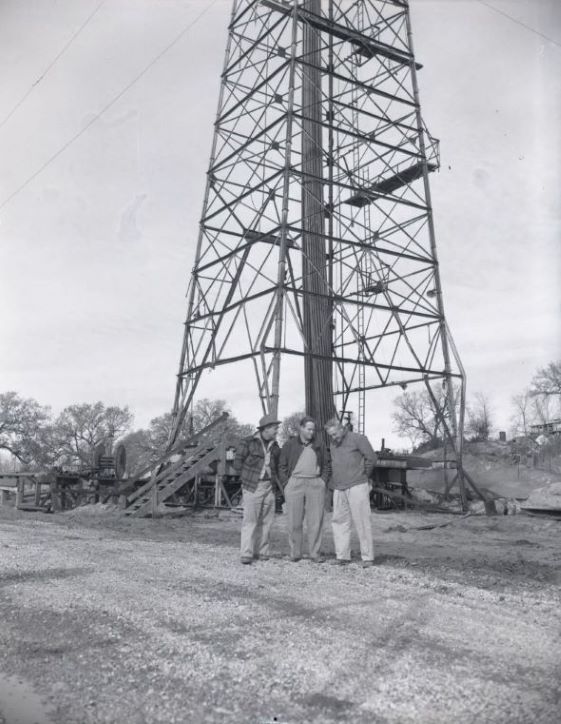
From the Los Angeles Times, December 30, 1948. Caption: "Discovery Well-From left, Ted Craig, E.D. Sherman and C.M. MacDougall, in front of discovery well in Newhall. Strike has brought boom scenes to tranquil town." Image from the Los Angeles Times Photographic Archive (Collection 1429), UCLA Library Special Collections, Charles E. Young Research Library, University of California, Los Angeles.
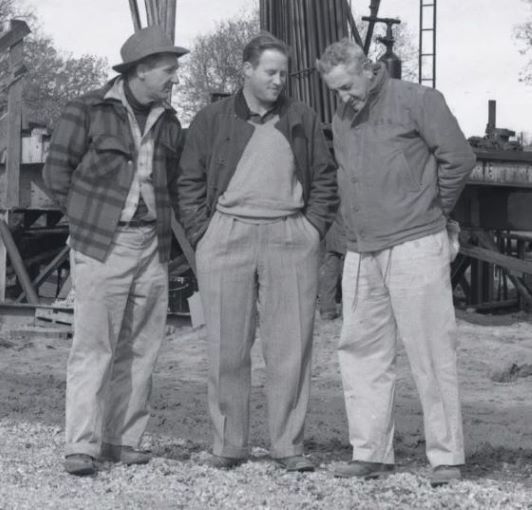
Close-up of men in previous photo showing from left to right, Ted Craig (one of the drillers), Elliot D. Sherman (son and partner of Richard H. Sherman and also a geologist) and C.M. MacDougall (the landowner).
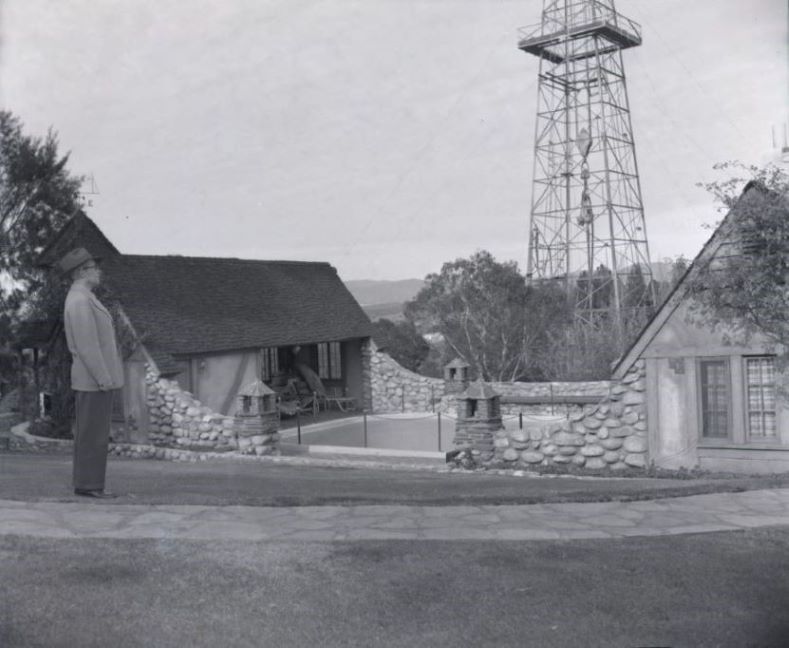
From the Los Angeles Times, December 30, 1948. Caption: "It Can Happen - Arthur C. Miller, Newhall attorney and Justice of the Peace, looks across his patio and swimming pool as oil drilling starts in 'strike' that has once tranquil community buzzing like historic boom town." Image from the Los Angeles Times Photographic Archive (Collection 1429), UCLA Library Special Collections, Charles E. Young Research Library, University of California, Los Angeles.
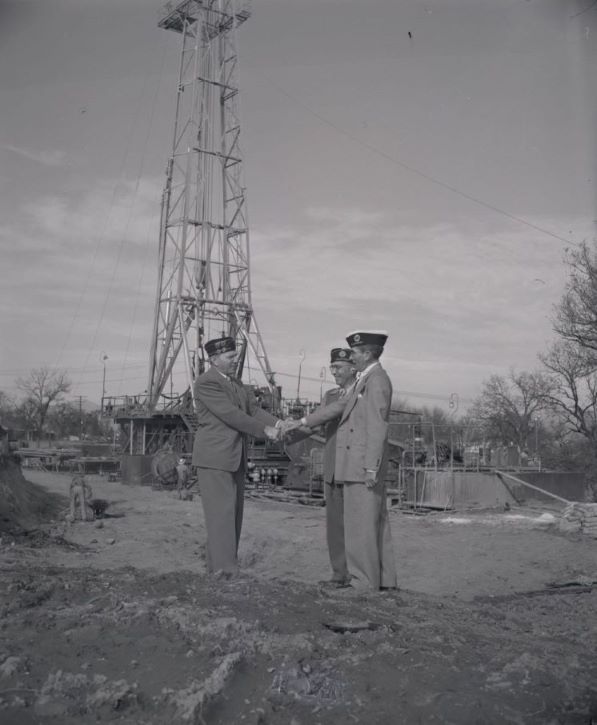
From the Los Angeles Times, January 1, 1949. Caption: "Congratulations- With the oil drill on the Newhall American Legion clubhouse site making record time, Legionnaires J.T. Salmond, left; Ralph W. Overton, center, and Sam H. Hyman can congratulate each other. Post has received bonus on lease." Image from the Los Angeles Times Photographic Archive (Collection 1429), UCLA Library Special Collections, Charles E. Young Research Library, University of California, Los Angeles.
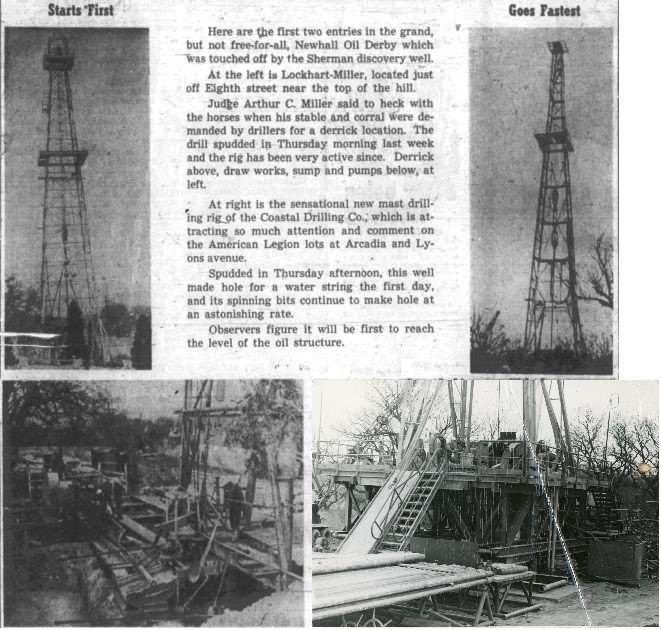
Newhall Signal, January 6, 1949. The lower right photo (replacing the original poor quality newspaper photo) is from the SCV History photo collection (AP2123). Written on back of that photo: "Newhall townsite oil boom 1949. Sumps on Hill (now Wayman St.). A derrick floor. 1950."
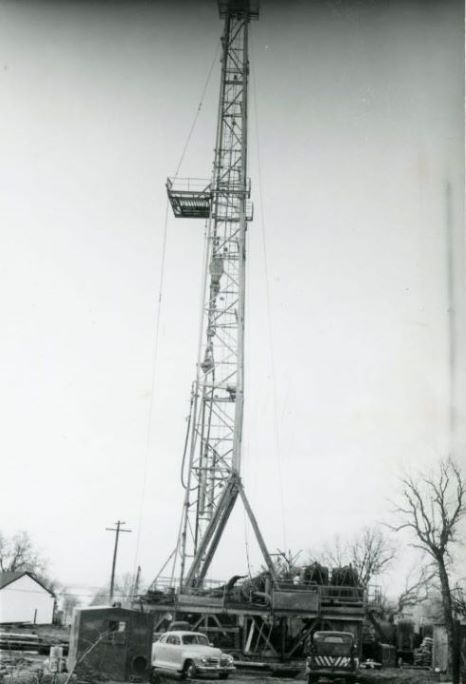
Written on back of photo: "Going up Arcadia St. by residennce of Mrs. Eva Wood (Mrs. William Pullar). Pullar's garage in corner. 1949" From the SCV History photo collection (AP0819).
On January 6th, 1949, the Signal reported that three wells have spudded in and many more are scheduled to start soon. Also reported was that the Sherman well 3-1 had quit flowing and, as usual, no information was provided by Sherman. It was believed that salt water had invaded again. The paper also complained how the landscape of Newhall was being ruined. "Arcadia valley has become a splendid example of what townlot drilling operations will do for the geography of a community. Between the discovery well and the Arcadia Street ridge are two huge sump pits, filled with mud, slime and oil scum. These giant mud holes are directly behind the back windows of expensive homes on the west side of Arcadia street. The south end of the Arcadia valley looks like a battlefield. Huge bulldozers have torn the hillside on the west down into terraces of raw yellow clay, cut by the slopes of roadways."(12) Then it was reported that the Sherman well was back into production, but 50% was water. To shut off the water, the well would go off production and be re-cemented. Also mentioned was that news about the other wells being drilled was being censored by the operators.(13)
The Signal of February 3rd gave a summary of the Sherman well reprinted from the Herald Express of February 2: "Briefly the story of Newhall is this. R.W. Sherman brought in the discovery well flowing about 1500 barrels daily of 40 gravity oil. The venture, however, lasted only a few days and went to water. Sherman for several months now has been attempting to shut the water off. These efforts have led to plugging off the well until there is left only 25 feet of productive zone from an original 60 feet of pay."(14) Another article from the Signal said that "there was indication that for the first time a glimmer of doubt is beginning to appear in the minds of some property owners as to the worth whileness of oil booms. Without a drop of oil having been produced in the past three weeks, the increasing destruction of residental property values has begun to assume a much larger place in a great many minds. If the wells now drilling produce their hoped-for floods of rich, black gold all doubts and disappointments will vanish. If, on the other hand, the black gold fails to show, then a part of Newhall at least will be stuck with an irreparable mess."(15) 1,500 barrels daily would always be just a guess. Well records show that no well in the Newhall Townsite field, including Newhall Community 3-1, produced anywhere, even remotely, close to 1,500 b/d.
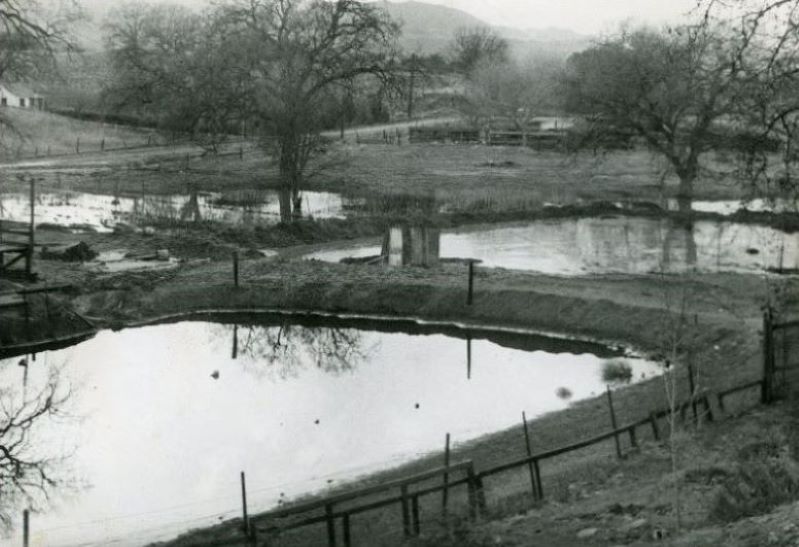
"Two of the three ponds in this picture are not really ponds at all, but huge 'sumps' or mud reservoirs. They were scooped out and filled by the Sherman discovery well operators, and they lie directly under the back windows of the nice homes on Arcadia street. The Sherman sumps now have a layer of black oil over the mud. County industrial waste inspectors are checking closely on the threat which large accumulations of drilling mud and salt water create against the underground fresh water chanpels." Newhall Signal, January 27, 1949. The original image from the newspaper is replaced by a better quality image from the SCV History photo collection (AP2127). Written on back of photo: "Sumps on Hill St (Wayman St)."
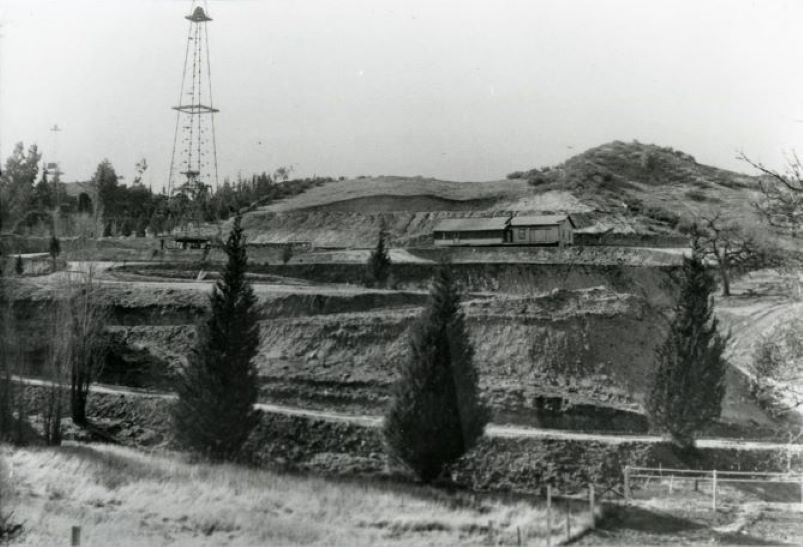
"This is the west slope of Arcadia valley, as landscaped for petroleum operations. Once a smooth, rounded hillside, part of which was selected by the Charley Mack for the site of three elaborate and expensive homes, it is now a series of raw terraces of yellow clay, connected by ramps of the same material. What would happen to this terrain in a typical California cloudburst needs no description." Newhall Signal, February 3, 1949. The original image from the newspaper is replaced by a better quality image from the SCV History photo collection (AP2125). Written on back of photo: "Arcadia St. about at Eighth, 1949. North of Arthur Miller house."
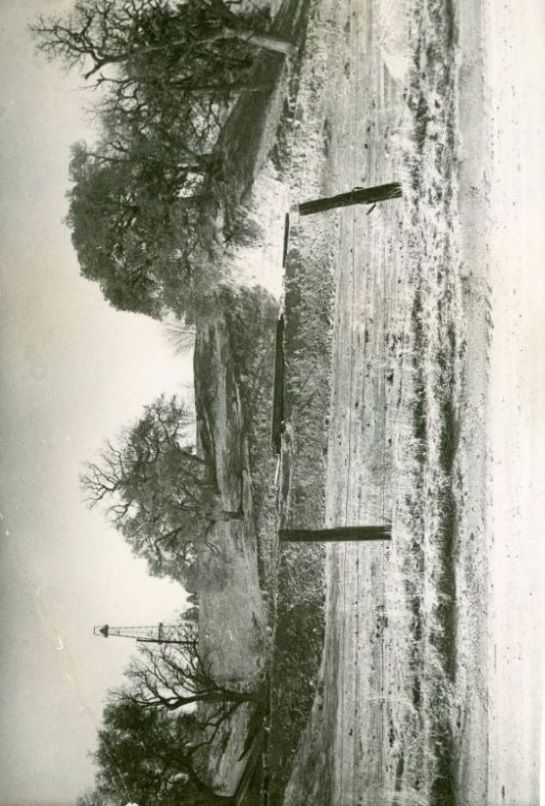
"Here are the hills along the west side of Newhall avenue, between Eighth and Ninth streets - the beautiful Arcadia ridge. They have been gouged and scored for derrick sites and derrick roads, until little semblance of their old contour remains." Also from the Newhall Signal, February 3, 1949. The original image from the newspaper is replaced by a better quality image from the SCV History photo collection (AP2122). Written on back of photo: "Signal 1949. Newhall Ave. site (Phillips property)."
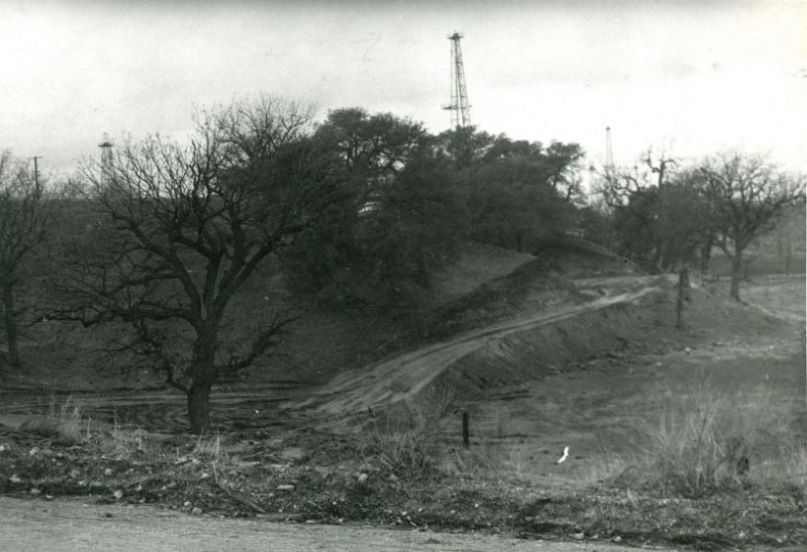
Photo from the SCV History Photo Collection (ms0003-138). Written on back of photo: "Hill St. wells - townsite boom. Newhall 1949."
The Signal of February 10, 1949, reported that the Eagle Bishop 1 well, which they called the "proving well," found no oil. The same week saw the Legion well and the Lockhart-Miller 1 well turn up dry. However, the Sherman 3 discovery well was flowing again with a "strong flow of high gravity oil" although still with 30% salt water, but the "salt water settled out easily in the storage tanks to less than 1 percent in the oil being trucked away. Net production was being restricted to about 400 barrels per day." The Signal's petroleum analyst wrote that "one thing may be positively stated: there is no more basis for the extreme pessimism reflected in some quarters than there was for the too exuberant optimism of last November."(16)
The Los Angeles Times well-known oil reporter Howard Kegley, wrote in his California Oil News Column that "there were headaches at Newhall Townsite yesterday when three seemingly promiseful drilling jobs folded up in almost one, two, three order." The three were Eagle-Bishop 2 on the American Legion lease, Miller 1 on Judge Miller's property, and Lutge 1. The abandonments were "said to have resulted from discovery that the sands were thin and much too tight to give up the oil."(17)
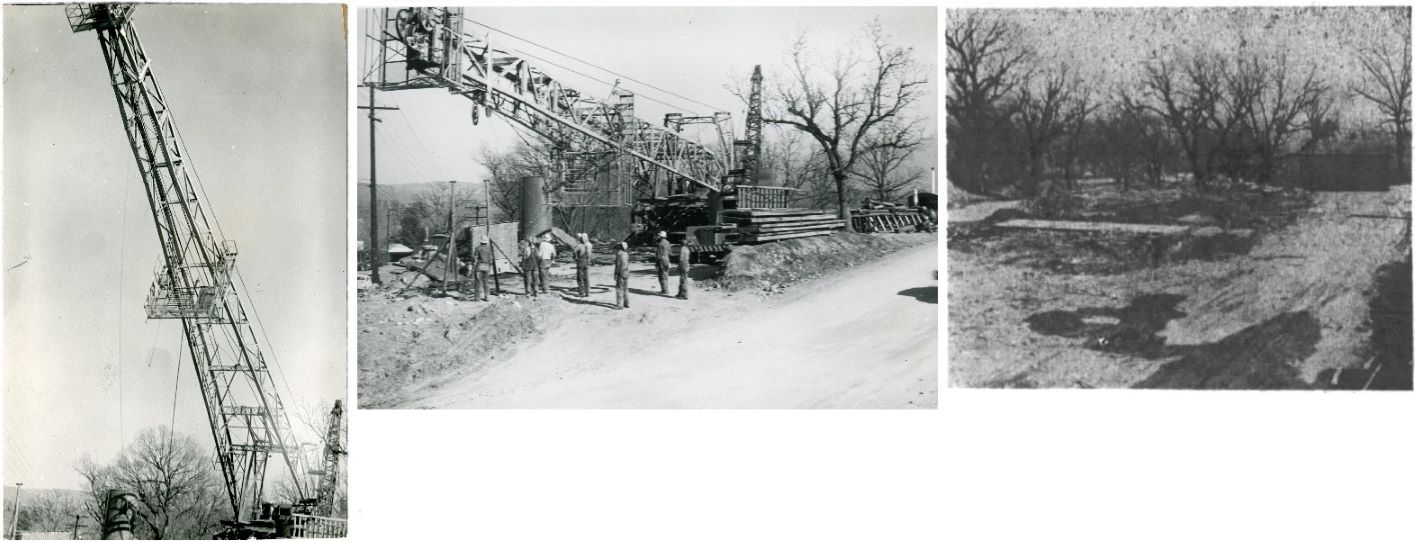
Derrick being removed by Eagle Oil Company from their Newhall Townsite dry well [Bishop 2]. From the Newhall Signal of February 24, 1949. I replaced two of the newspaper images with images of the original from the SCV History Photo Collection. The photo on the left is MS0003-126. The photo in the middle is AP2126. Written on the back of the middle photo: "Rig coming in for the Legion well on Arcadia St. 1949."
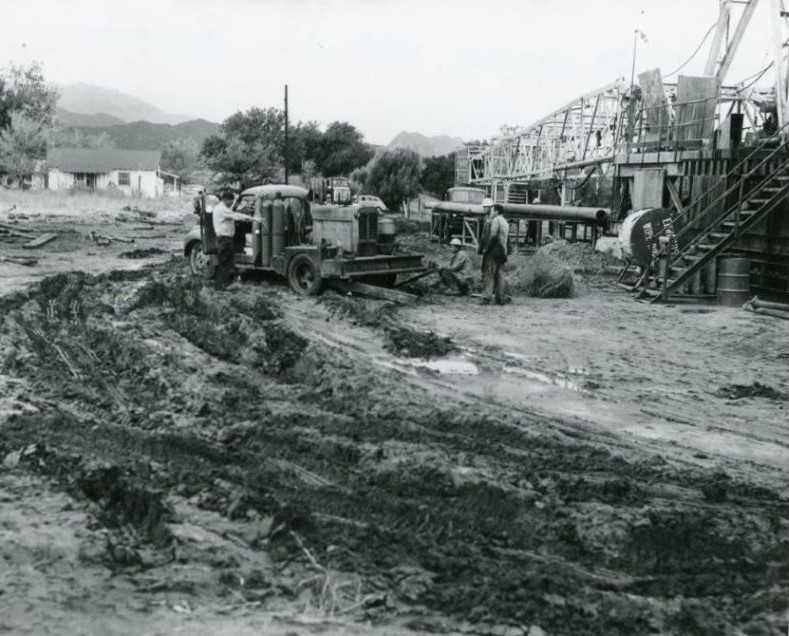
Photo from the SCV History Photo Collection (MS0003-127). Written on the back of the photo: "Arcadia St scene 1949. McGrew home on left. Legion well looking west. House on SW corner intersection of Lyons & Arcadia."
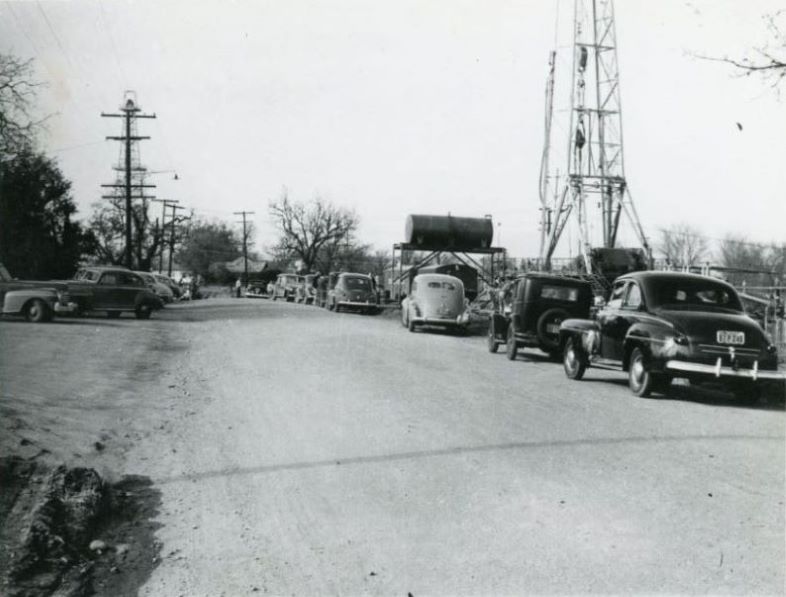
Photo from the SCV History Photo Collection (MS0003-129). Written on the back of the photo: "Arcadia St. Taken in front of Pullars looking North"
The February 17th, 1949, Signal reported that "over the weekend the Arcadia street phase of the great Newhall oil boom passed into history." The Signal also quoted Alex N. Campbell in the Herald-Express of the previous day. Campbell wrote that "the Newhall boom has burst. Possibly the hottest, most aggressive leasing and drilling campaign in years has come to a virtual standstill. Five of the eight drilling wells have suspended or abandoned." "It is understood that approximately 40 drilling locations were ready to go in this area if it had proven up." "As the situation stands today the 'discovery well,' R.W. Sherman's Newhall Community No. 3-1, has been killed. The last production record on the well showed only 42 barrels daily production. The well had made as high as 1,500 barrels daily [well records show that it never made that much]. The venture will be reworked in an effort to bring it back." Work on Sherman's second well, Newhall-Community No. 2-1, was suspended. Sherman was also drilling a third well, Community No. 1-1. The Signal's petroleum reporter Pico y Pala (an alias used by Arthur B. Perkins, the town's first historian) commented: "Forget the 'Townsite' application and call it the Sherman Field. There is one, make no mistake about that; and, fortunately for the home owners and residents of Newhall, it isn't going to be developed in the residential area."(18)
The names of the Sherman's Newhall Community wells are somewhat confusing. The first well drilled was 3-1, then 2-1, and finally 1-1. You might think that the sequence should be reversed. However, Sherman had three leases. They were named Newhall Community 1 (consisting of 60 acres in Lot 121 of Tract 1089), Newhall Community 2 (25 acres in Lot 97 of Tract 1059), and Newhall Community 3 (80 acres in the Newhall townsite). Thus, the first well drilled was on the Newhall Community 3 lease, hence the name Newhall Community 3-1. The last well drilled was Newhall Community 1-1, drilled on the Newhall Community 1 lease. So, only one well was drilled on each lease.
Interest was shifting westward to Happy Valley. Sherman was leading the way. Operators "will probably let the Sherman interests do the pioneering, and if Sherman strikes anything the rest will try to get in as close as possible. This pattern of action proved disastrous on Arcadia Ridge, but that seems to be the way they work."(19) Interest may have been shifting there, but nobody would be drilling there soon.
"Old Faithful blows in again" is the headline of the March 10th Signal. As far as I can tell, this is the first time Sherman's Newhall Community 3-1 well was called Old Faithful. It had blown gas, with evidently some oil particles, out starting Tuesday (the 8th) morning and lasting all day. Then it just stopped. Another well still being drilled (Phillips 1) in the townsite field was called "a well to end all wells in the town lot area."(20)
On the 17th, a week later, the Signal's headline was "All drilling on Newhall townsite leases suspended." Phillips 1 had been abandoned with no oil found. "Old Faithful, the original discovery well, was rumored to be flowing oil into the tanks, but how much nobody knew but the Shermans and they [meaning father R.W. and son E.D.] were not telling. All the others were definitely down. As a further confirmation of the end of the townsite bubble, the big bulldozers of Bennett Murphy began work on restoration and clean-up of drilling sites. The sumps of the two Eagle wells on the Legion lots and the Chappell property were covered up and smoothing over of the ground was in progress." "With the exception of the Sherman No. 1, all of the other wells have been abandonments, with the holes cemented up." The Signal petroleum writer (Pico Y Pala, aka A.B. Perkins) reported that "all in all, Newhall Townsite can look back on its 100 days in the limelight with smug complacency, lots of oil lease cash, but no oil. It's been a wonderful merry-go-round ride. However, the impression that Sherman's field is dead is completely false. It isn't in the picture of things to have a well behave as that well has behaved and be the only productive oil puddle around. The Sherman field will very probably be under development during 1949..."(21)
The Oil & Gas Journal reported that "Exploration in the Newhall townsite area of Los Angeles County, inspired by an oil discovery there several months ago, has been entirely unsuccessful to date and interest in the possibility of developing further production appears to have lapsed."(22)
"Old Faithfull Dies" is the heading of the March 24th Signal. "The last and final breath of life in the late lamented Arcadia ridge oil flurry expired last week, when R.W. Sherman threw in the sponge on Sherman No. 3. All operations were suspended about the derrick, and the portable drawworks removed. It is reliably reported that the last 'blow' of Old Faithful was practically all gas and salt water, and that the operators gave up hope of bringing in the well as a producer of oil."(23)
In May of 1949 it was reported that "some kind of doctoring operation on 'Old Faithful,' the original Sherman well in Arcadia Valley, got under way this week but, as usual, no information was available."(24) A week later, "operations by R.W. Sherman are reported to be at a complete standstill. California Production Service, which has been working on 'Old Faithful,' the original Sherman discovery well in Arcadia valley, was preparing to set a pump yesterday, in the hope of salvaging something from that prolonged and expensive experiment."(25) On June 2 "activity seems to have subsided...and no information was available." "Among oil men, the career of this well, which started and also stopped the biggest oil flurry the town of Newhall every had, is a topic of never-ending speculation."(26) Then, another week later on (remember the Signal was only published once a week on Thursday) "Making the final, complete end of the Newhall townsite oil boom, riggers this week began tearing down the derrick of 'Old Faithful,' the original Sherman well in Arcadia valley. This rig was erected in July last year as the first of the nine or ten which took part in the flurry. Arcadia street residents were hoping the huge, oil-covered sumps would follow the derrick."(27)
R.W. Sherman had done a lot of work on his wells which cost a lot of money. Unfortunately, he was not paying his sub-contractors, like the Halliburton Oil Cementing Company and the Buass Drilling Company. Now, they decided to take action. According to the Signal of July 7th, a lawsuit was filed against Sherman by the two companies for unpaid bills of $92,000. Also, mechanic liens were filed against the properties in the three community oil leases Sherman had.(28)
A creditors' meeting was held on the 12th. It was discovered that Sherman's liabilities were more than half a million dollars. If he liquidated, creditors would only get 50 cents on the dollar. A trustee for the creditors was assigned to work out an agreement between the creditors and Sherman. That agreement would give Sherman 120 days to try and generate cash from his Newhall leases. He would be given an advance of $50,000 to redrill the 3-1 and the 1-1 wells. The $50,000 would come from the Hellman estate of Los Angeles, who then would be first in line to get any money before the creditors. The mechanic liens would be dropped.(29) However, that agreement was not accepted by the creditors and, on August 5th, Sherman filed a petition in Federal Court for a hearing of bankruptcy.(30) The case would be postponed multiple times.(31)
In October of 1949, another problem arose for Sherman when Mr. and Mrs. Ralph Williams filed suit in Superior Court against Sherman, the Shell oil Company, and others, asking for damages of $20,000. They claimed that the drilling caused the earth to vibrate which caused damage to the Williams' personal property inside of the house and made it difficult to sleep. Also, the air was filled with fine material and black oily substances which did damage to the outside of the house and the smells were obnoxious.(32) I could not find out how the case was settled, but it is possible that they were one of the creditors when Sherman was in bankruptcy and received some money when that was settled.
An agreement was finally approved by the Federal Bankruptcy Court in January of 1950 where Sherman 3-1 would be re-drilled, but the property liens were not dropped. "The new try, if it clicks, may pull Oilman Sherman out of his troubles, and be the start of another scramble to get at the 40 gravity petroleum proved to exist by Sherman 3-1, and found by no other wildcat in the vicinity (and there were eight of them at one time)."(33) The re-drilling would be handled by the Fremont Oil Company, who would hire the Pike Drilling Company to do the job. Fremont Oil also would receive a 50% interest in Sherman's leases. "On the site of Sherman 3-1, 'Old Faithful', a full size mast derrick was hoisted Thursday enening...Somewhere along the depth of this hole, windows are going to be cut in the casing, and the drill stem will whipstock out into new routes downward...This analyst holds that the crest of the Arcadia ridge, perhaps Arcadia street itself, marks the line of a deep fault which constitutes a dam against any oil structures west and south of it. This fault, at both ends of Arcadia street curves in a manner to form a horseshoe shaped arc around the Happy Valley bowl."(34) Considering that the analyst was non-geologist Arthur B. Perkins (Pico Y Pala), this was quite a guess. It was never confirmed. No oil would be found in the bowl of the horseshoe, Happy Valley.

The caption is from the Newhall Signal of January 26, 1950. It included the photo, but I replaced the photo with a better version (AP2025) from the SCVHistory photo collection. Written on back of photo: "Old Faithful - the RW Sherman well on Hill (west of MacDougal's home on Arcadia St. Hill St is now called Wayman St."
On February 9th, 1950, the Signal reported that the Sherman well "drill penetrated 17 feet of promising oil sand at a depth of 5695 feet. A core taken from this sand is reported literally to have 'exploded' from the drill stem." and "Word of the strike ran like wildfire about the town, but definite details were lacking and of course will be lacking until a formation test is made."(35) The next week, the Signal said that the "Sherman well now water-proofed" from top to bottom.(36) Another week later the Signal headline was "Old Faithful still stumps experts." "To all appearances, the second drilling job is turning out just like the original one."(37) Then, "Old Faithful was faithfully duplicating its original performance, and the Fremont Oil Company was reported to be about at the end of its patience, or maybe, treasury." The well had spurts of petroleum but more spurts of salt water. "The attempt to resurrect this well has been an agonizing experience for everybody concerned."(38) By March the 9th, "the rig has been lowered, but none of the equipment removed."(39) On the 23rd, it was reported that the "Pike Drilling Co. finally picked up its rig at the site of Old Saltwater Faithful in Arcadia Valley and moved it to the San Joaquin Valley."(40)
However, documented in the well records but not reported in the newspapers, was that work on Newhall Community 3-1 started up again on March 24th. Either the original rig was not picked up as just reported, or another one was set up. Whatever happened, operations began again on the well. After that work was done, it was put on the pump from May 11 until May 14 and was getting 200 b/d, but the buildup of sand and silt was causing problems. The operators pulled the pump and sucker rods and cleaned out the borehole with circulating oil and fresh water. That was evidently an involved operation because the well was not back on the pump until June. From June 11 until June 20 the well was giving 175 b/d, but with 95% salt water. Pulling out the pump and rods again they tried cleaning out the hole again. Pumping resumed and lasted from June 25 to July 10. They were getting 200 b/d of mostly salt water. They again pulled everthing out and cemented at the level they believed the salt water was entering. On July 20, back on the pump, they got only 50 barrels of what appeared to be circulating oil and nothing more. The oil company gave up. The well was left idle.
Some good news for the property owners with liens was reported in September of 1950 when, evidently, Sherman finally reached a settlement with his creditors. They would receive 50 cents on the dollar and the liens on the lease properties would be removed.(41) Somehow he apparently retained at least some of his leases - not only the three Newhall Community leases but his Braille Institute lease and maybe his Happy Valley lease.
Sherman's failed Newhall Community 3-1 well had been called the Newhall Townsite discovery well by newspapers, but it was never commercially successful. In April of 1951, the Long Beach Press Telegram reported that the Newhall Townsite oil field had been designated with Braille No. 1 as the discovery well. Braille No. 1, drilled by the Talisman Oil Company in March of 1951, had found a commercial quantity of oil at a depth of 3970 feet.(42) The president of Talisman was, yes, R.W. Sherman. He was funded by the Continental Oil Company. Even though he failed in the townsite field, Sherman was still highly regarded as a petroleum geologist, so he could still get backing. This well, located just behind Art Grayson's Shady Auto Court on San Fernando Road (now Newhall Avenue - and called the Newhall Mobile Home Park) was placed on the pump and produced 75 barrels a day.(43) CalGEM also called the Braille 1 well the discovery well of the townsite field.(44) Note that there was another Braille 1 drilled in 1946 but that was a different well. The well records of the discovery Braille 1 (03713242) say that a depth of 3196 feet was reached with an initial production of 100 b/d with a production after 30 days of 30 b/d. The Talisman Oil Company followed Braille 1 with Braille 2 in April of 1951, but Braille 2 found no oil (just like the first Braille 2 in 1947). In October of 1951, Continental would take over the lease from Talisman and, in 1957, they would sell the lease to the Southwest Oil Company.
In October of 1951, Happy Valley, just west of the Newhall Townsite but part of the new Newhall Townsite oil field, was touted by Joe Aidlin, a former president of the old Newhall Water Company, as a potential drilling site.(45) So far, no wells had been drilled there even though it was just west of the Arcadia Street boom started by Sherman. Sherman probably had a lease there, but he had, as yet, not done any work. Aidlin tried to interest the owners of properties in Happy Valley to combine into a community lease, but that never happened.(46)
It would seem that Sherman was not done with Old Faithful yet. In April of 1953 it was reported that he "is working to reach a definite position with regard to his oil leases in the Newhall townsite." "Within the next 90 days, the report says that he will either have another well going, or will quitclaim all of his leases. Recently a pump was install on 'Old Faithful', the original discovery well in Arcadia hollow, and some recovery of oil is being made." But no news of Sherman's decision was published.(47) However, Old Faithful was officially plugged and abandoned in August of 1953.
Finding more backing, Sherman finally decided to head west into Happy Valley where he either still had a lease or he negotiated a new one. In a Signal of November of 1954 the headline was "Sherman come back try launched with well on 10 acs. in Happy Valley."(48) The well would be located in "Unit E" on property adjacent to Apple Street near Cherry Street. It was called Happy Valley Unit E No. 1 (03713211) and was spudded on November 12, 1954. The Signal warned folks to "don't start spending your royalties just yet."(49) The well was drilled to a depth of 7041 feet, but no oil was found. Sherman actually wrote an explanation letter to the lessors concerning the failure of the well.(50) It was was plugged and abandoned in February of 1955.
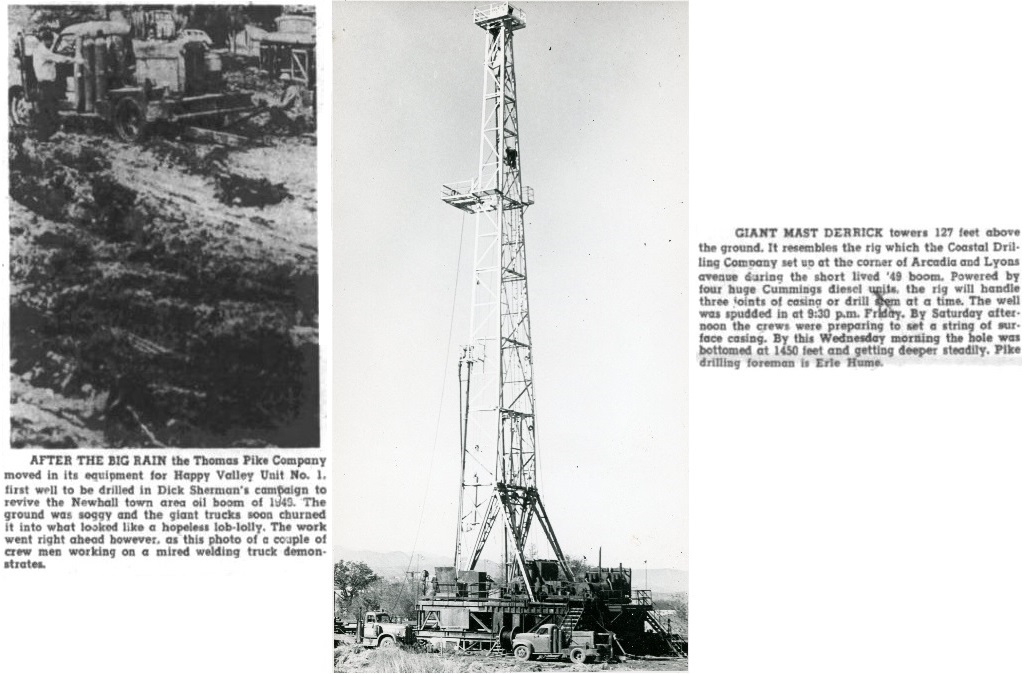
Happy Valley Unit E No. 1. From the Newhall Signal of November 18, 1954. The derrick photo in the newspaper was replaced by the original image from the SCV History photo collection (AP2128)
Sherman then moved to a different location in Happy Valley for a second well - the Miller Ranch No. 1 (03713212).(51) This well was spudded on January 27, 1955.
On March 3, 1955, Richard W. Sherman suffered a "critical" heart attack at his Pasadena home. However, he improved and "would be out soon."(52) The Miller Ranch 1 well was completed on March 28 at a depth of 7638 feet, but, again, no oil was found. Sherman was resting at home but still in serious condition.(53) The well was plugged and abandoned in April. Sherman retired.
Three years later, on March 13, 1958, nearly ten years since he started the oil excitement in the Newhall townsite, Richard Wade Sherman died in San Marino, California. He had never really recovered from his 1955 heart attack. Sherman was buried in Forest Lawn Cemetery in Glendale.(54)
According to CalGEM records, only three more wells were drilled in the Newhall Townsite oil field after Sherman's death. Appropriately, they were all "dusters".
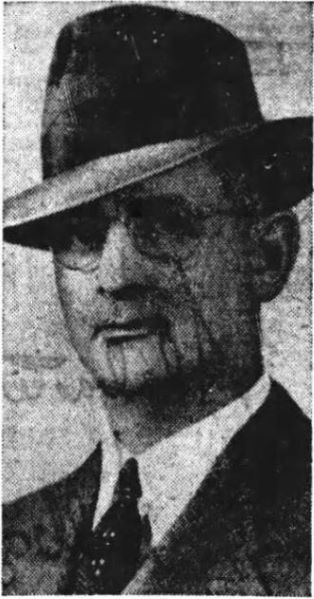
The only photo of Sherman that I could find was this poor quality one from the Los Angeles Times of March 23, 1942.

Final Thoughts
One things that puzzles me is why no Newhall Township well was drilled deeper than 10,000 feet. The Happy Valley Unit E 1 and the Miller Ranch 1 wells both went over 7,000 feet, but only one well reached even 8,000 feet. It was mentioned in several newspaper articles that there were plans to go 10,000 feet deep, but nobody did. The Newhall-Potrero oil field had seven oil producing zones, two over 10,000 feet. There were plenty of producing wells over 10,000 feet. The Del Valle oil field's deepest well was 13,035 feet. Sherman's Newhall-Community 3-1 well's final total depth was 5,846 feet, but the production zones were reported to be 5,575 - 5,595 feet and 5,635 - 5,680 feet. Since those producing zones didn't produce for anyone, why didn't someone drill deeper? Since Sherman, a very respected petroleum geologist, didn't go deeper, was that enough to discourage others from trying? I wonder if lurking deep under Newhall there is a large pool of untapped oil. Of course, no one would ever be permitted to drill a well there anymore, so we'll never know.
Sources


















